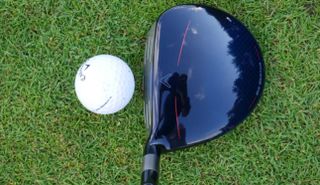Callaway Big Bertha B21 Fairway Wood Review
We analyze the looks and performance of this slice-fighting fairway wood

The Callaway Big Bertha B21 fairway wood is a brilliant option for most club and handicap golfers, especially if you struggle with a miss to the right or to get the ball up in the air. The look at address inspires confidence, with the forgiving performance launching the ball high with a good amount of backspin to keep it airborne.
-
+
Confidence-inspiring to look down on
-
+
Very forgiving
-
+
High launching
-
+
Noticeable increase in distance during testing
-
-
Offset look takes some getting used to
-
-
High launch and spin won't suit all player types
Why you can trust Golf Monthly

Callaway Big Bertha B21 Fairway Review
Callaway’s Big Bertha brand is synonymous with quality and innovation in the metalwood market and, in recent years, it’s been tied to the models that tend to be easier to launch and are more forgiving.
With the Big Bertha B21, it’s immediately obvious that that’s exactly what it is designed to be when you take the headcover off, with this model ranking amongst the best Callaway fairway woods on the market.
To begin with, the shape and profile behind the ball inspires huge amounts of confidence. It looks like there’s a lot of loft there, with the silver face contrasting sharply against the dark crown to assist with alignment.

What will also provide confidence is the overall shape, as the B21 has a pretty straight bottom edge along the face, a shallow profile and a deep head from face-to-back. This means that the user should have no problem getting the ball up in the air quickly, although the offset design may take some getting used to.
But players who have no confidence getting fairway woods off the deck should be able to get the ball airborne with this club. After all, Callaway are known for producing some of the best fairway woods that money can buy.
Moving to the performance, and specifically the feel and sound across the face, which is really solid and consistent. Overall, it's a little closer to the titanium woods of a few years ago than the more recent carbon composite creations.
There’s definitely plenty of forgiveness there, as the performance didn’t drop off too much on off-centre strikes. The offset also really helps anyone who struggles with a slice to keep the ball in play, as it also interacts well through the turf and is effective from a variety of different lies too.

Upon impact, the launch and flight is noticeably higher than most other fairway woods and it generates more spin than some of the more powerful models on the market (many of which are aimed at the better player).
Therefore, the Big Bertha B21 is perhaps aimed more towards the mid and high handicapper range, as the higher launch and spin are exactly what many club and handicap golfers need to keep the ball in the air and maximise carry distance.
It is worth noting that better players might prefer a more penetrating and lower-spinning flight, especially off the tee. The B21 also seems to have a little more draw bias built in than a traditional fairway wood, so slicers seeking a straighter flight should experience this with the Big Bertha.
If you do decide to buy one of these fantastic Callaway golf clubs, first look at one of our Callaway coupon codes.
Get the Golf Monthly Newsletter
Subscribe to the Golf Monthly newsletter to stay up to date with all the latest tour news, equipment news, reviews, head-to-heads and buyer’s guides from our team of experienced experts.
Kit Alexander is a golf broadcaster and journalist who commentates and presents for the DP World Tour, PGA EuroPro Tour and Rose Ladies Series. He has over 15 years’ experience of magazine and television work in the golf industry and is a regular contributor to Golf Monthly.
- Matt CradockStaff Writer
-
 'Gator Netting Is In Place' - Chevron Championship Venue Prepared For 'Safe' Winner's Jump
'Gator Netting Is In Place' - Chevron Championship Venue Prepared For 'Safe' Winner's JumpA tradition which began at the tournament's previous home could continue this year - if the champion is feeling brave enough...
By Jonny Leighfield Published
-
 'Women's Sports Just Needs A Stage' - World No.1 Nelly Korda On Bringing Caitlin Clark Effect To Golf
'Women's Sports Just Needs A Stage' - World No.1 Nelly Korda On Bringing Caitlin Clark Effect To GolfWorld No.1 Nelly Korda has won her last four tournaments - but can she help elevate golf in a similar way to what Caitlin Clark has done with women's basketball?
By Elliott Heath Published
-
 Chevron Championship Prize Money Given Huge Boost With Winner Set To Receive Over $1 Million For The First Time
Chevron Championship Prize Money Given Huge Boost With Winner Set To Receive Over $1 Million For The First TimeThe first women's Major of the year benefitted from a couple of exciting decisions as Lilia Vu attempts to defend her title
By Jonny Leighfield Published